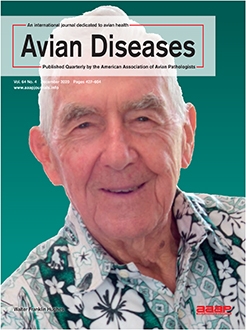Histologic and bacteriologic features for groups of average 31-day-old broilers displaying three gross categories of femoral head alterations were documented. Categories included simple femoral head separation (FHS), femoral head transitional changes (FHT), and femoral head necrosis (FHN). Groups with grossly normal (NORM) femoral heads and cull birds with FHN and having gross signs of sepsis (Cull-FHN) were also included in the study. There was a 10% occurrence of positive bacterial cultures for all birds tested. Most positive cultures (33%) were found in the Cull-FHN group, while only a 12% occurrence was seen in the FHS group, and no positives were present in the FHT or FHN groups. A 14% total occurrence of femoral bacterial chondronecrosis with osteomyelitis or simple osteomyelitis (BCO-O) was observed. A progressive increase in the prevalence of BCO-O was apparent between groups going from NORM (0%), FHS (4%), FHT (14%), FHN (13%), and reaching a maximum of 67% in the Cull-FHN group. Minimal to mild femoral head cartilage necrosis was present in 40% of NORM broilers and 100% of the FHS, FHT, and FHN groups, but at moderate severity in 20% of the Cull-FHN group. Thus, the majority of FHN cases were associated with aseptic cartilage necrosis rather than BCO-O. These findings suggest that aseptic cartilage necrosis may be as important as septic necrosis as a cause of gross femoral head disease. A 26% overall occurrence was seen for hip synovitis–arthritis, but group differences were not statistically significant. Synovitis was not seen in the NORM group and was present in some (12%) of the FHS group but was observed at a high rate in both the FHN (43%) and the Cull-FHN (50%) groups. Morphometric measurements demonstrated that the area size of femoral fibrous cortical defects or “cutback zones” were generally larger for all gross categories relative to NORM, with a significant difference between NORM and FHS groups. This study underscores the multifactorial etiology of FHN and the importance of conducting both histologic and bacteriologic evaluations in which gross evidence of FHN or BCO-O occurs.
How to translate text using browser tools
11 August 2020
A Field Study of Histologic and Bacteriologic Characterization of Femoral Head Separation and Femoral Head Necrosis
Floyd D. Wilson,
Craig L. Wyatt,
Philip A. Stayer,
Joan S. Schrader,
Katie A. Burchfield,
Frederic J. Hoerr
ACCESS THE FULL ARTICLE

Avian Diseases
Vol. 64 • No. 4
December 2020
Vol. 64 • No. 4
December 2020
bacterial chondronecrosis with osteomyelitis
bacteriology
broilers
femoral head necrosis
femoral head separation
histopathology




